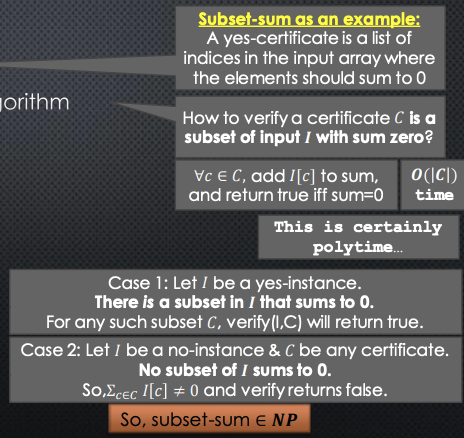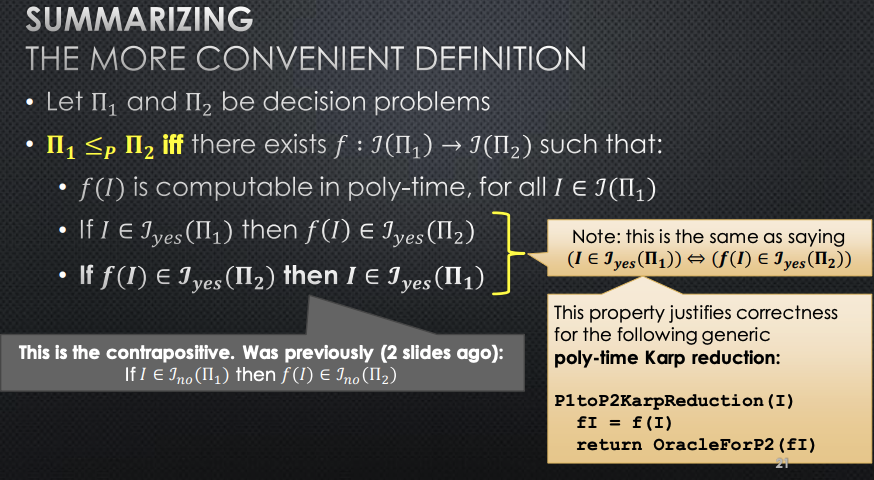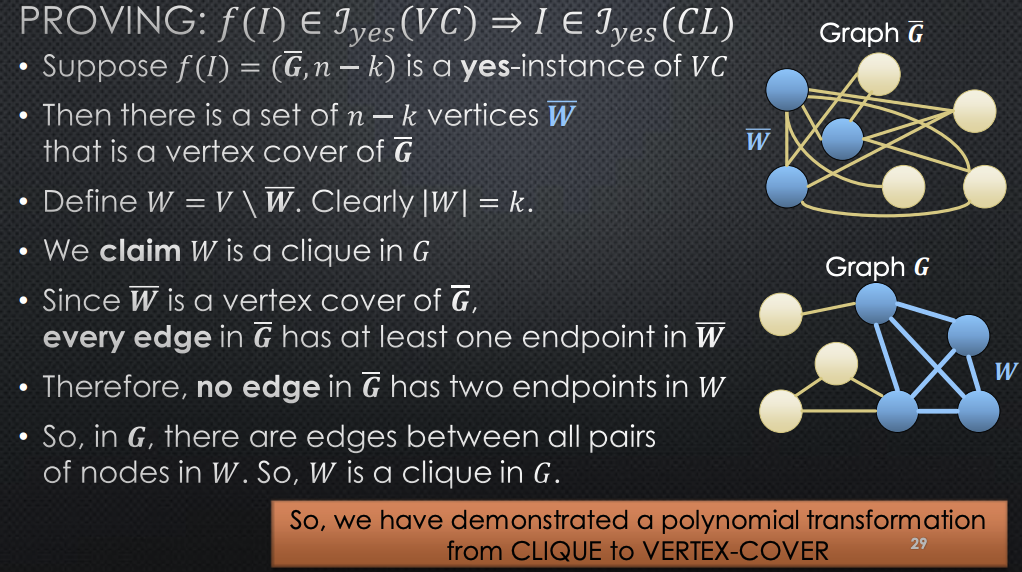Last time, we finished looking at reductions and just began to loop into the complexity class NP. In this lecture, we will cover:
- NP problems
- Oracles, certificates, polytime verification algorithms
- 2 problems in NP
- Subset sum
- Hamiltonian Cycle
- Relationship between P and NP
- Polynomial transformations
Complexity Class NP → Non-deterministic Polynomial Time
Recall that last example from last class → subset-sum problem. We wrote a polytime verification algorithm for the Oracle. Recall it is:
# given such an oracle, this algorithm would solve subset-sum
def SubsetSumWithOracle(I):
C = Oracle(I)
return verify(I,C)
def verify(I, C):
if C not subset of I then return false
return (sum(C) == 0)→ Dumb Sub-set Sum Algorithm:
- Pretend we are the oracle, and make certificates. For this problem, the type of certificate: set of integers.
- Say we had the following dumb sub-set sum algorithm:
def SubsetSum(X[1...N]):
for every possible subset S of X:
if sumzToZero(S) then return True
return False-
This algorithm generates every possible subset’s certificate
-
For each one, verify →
sumToZero(S) -
If any certificate sums to 0 → a yes-certificate, and we return
True -
A certificate that does not sum to 0 doesn’t really prove anything (would need to know all certificates sum to 0)
-
Generating all certificates is expensive (exponential time) → but verifying one is polytime on input size
-
If there was such a thing as a no-certificate, what would it look like? How long would it take to verify it?
→ Formal Definition of Certificates
-
Certificate: Informally, a certificate for a yes-instance is some “extra information” which makes it easy to verify that is a yes-instance
- A “yes-instance” refers to a specific input for a decision problem for which the answer is “yes.”
- For subset sum → you could give a subset that you claim sums to 0
-
Certificate Verification Algorithm: Suppose that
Veris an algorithm that verifies certificates for yes-instances. ThenVer(I,C)outputs “yes” if is a yes-instance and is a valid certificate for . IfVer(I,C)outputs “no”, then either is a no-instance, or is a yes-instance and is an invalid certificate -
In the case of NP problems:
- The verifier algorithm takes both the input and the certificate as its input.
- It checks, in polynomial time, whether the combination of the input and the certificate is valid and satisfies the conditions for a “yes-instance.”
-
The key characteristic of problems in NP is that, while finding a certificate (solution) might be computationally challenging, verifying a given solution is computationally easy.
→ Generalizing beyond Subset-sum
- You can solve any decision problem in non-deterministic poly-time given:
- A poly-time non-deterministic oracle, and
- A poly-time
**verify**algorithm
- Such that
- If is yes-instance → oracle returns a yes-certificate
- If is a no-instance →
verify(I,C)returnsFalsefor all
Defining NP
A decision problem is solved solved by a poly-time
verifyalgorithm. iff (note, “solved” is being defined here, we’re not trying to say if finds a solution for):
- for every yes-instance , there exists a certificate such that
verify(I,C)returnsTrue(that proves the answer is yes) ,and- for every no-instance ,
verify(I,C)returnsFalsefor every
- When we say an NP problem is “solved,” we mean that there exists a polynomial-time verifier algorithm that can efficiently check the correctness of a solution (certificate) for any given instance of the problem.
The above definition is crucial → when we are asked to show a problem is in NP → this is what we need to show
-
The complexity class NP denotes the set of all decision problems that could be solved by poly-time
verifyalgorithms
So, in P, the emphasis is on the efficiency of finding a solution, while in NP, the emphasis is on the efficiency of verifying a solution. The distinction is important in understanding the nature of problems and the classes they belong to in complexity theory.
- Note: it is not necessary to be able to implement an oracle for a problem to be in NP → we can simply assume an oracle exists, and show a poly-time
verifyalgorithm exists

→ Mechanics of Showing a Problem is in NP
- How to show
- Define a type of certificates
- Design a poly-time
verify(I,C)algorithm - Correctness proof:
- Case 1: Let be any yes-instance; find such that
verifty(I,C)isTrue - Case 2: Let be any no-instance, and be any certificate → prove
verify(I,C)is False
- Case 1: Let be any yes-instance; find such that
→ We Show this more throughly through another example → showing HC Cycle problem is NP
Another example: Hamiltonian Cycle
- Instance: An undirected graph
- Question: Does contain a hamiltonian cycle?
Let’s show this problem is in NP! We are looking to find a poly-time verify algorithm…
- Type of certificate? → Array of nodes, which may or may not represent a Hamiltonian Cycle
- How to verify that given an array of nodes, they represent a Hamiltonian cycle.
def HamiltonianCycleVerify(G=(V,n,E,m), X):
if size(X) is not n then return False
used[1...n] = array containing all False
for i = 1 .. n:
if used[X[i]] then return False
used[X[i]] = true
for i = 1 ... (n-1):
if no edge X[i] to X[i+1] then return False
if no edge X[n] to X[1] then return false
return True- This is a
verifyalgorithm we imagine being called on the certificate produced byoracle(G) - Correctness proof:
- Case 1: If is a yes-instance of the problem → find some certificate for which this procedure returns true
- If is a yes-instance, there is a hamiltonian cycle. Suppose is a sequence of n consecutive nodes on that cycle → then this returns true
- Case 2: If is a no-instance of the problem → every certificate should cause
verifyto return False- ==Almost always, we prove the contrapositive==
- If some certificate
verifyreturns true, then is a yes-instance - If we return true, then the graph contains cycle with n distinct nodes → proves existence of HC in , which means is a yes-instance
- If some certificate
- ==Almost always, we prove the contrapositive==
- Case 1: If is a yes-instance of the problem → find some certificate for which this procedure returns true
How are P and NP related
-
- Consider a problem
- We show there exists a poly-time
verify(I,C)SUCH THAT:- For every yes-instance of ,
verify(I,C)= true for some - For every no-instance or ,
verify(I,C)= false for all
- For every yes-instance of ,
- By definition, there is a poly-time algorithm to solve
- Implement
verify(I,C)by simply running → ignoring - We can completely disregard the certificate since we can already solve this problem in poly-time on every input. So we just run the algorithm on the input
- Regardless of what is,
verify(I,C)satisfies the above
- Implement
- How about → Million dollar question. We strongly suspect it is not, we cannot solve it
Polynomial Transformations
→ A subclass of poly-time reduction commonly used for NP-completeness and impossibility results
-
So whats a polynomial transformation?
-
Some previous transformations we have seen the are reductions in previous lectures
-
A polynomial transformation is a like a special case of a poly-time reduction where we transform the input once and we call the oracle once, and we return the value the oracle returned. Single call to oracle is key here.
→ Here is the formal definition
- For a decision problem , let denote the set of all instances of . Let and denote the set of all yes-instances and no-instances respectively of .
- Suppose that and are decision problems. We say that there is a polynomial transformation from to (denoted ) if there exists a function: such that the following properties are satisfied:
- is computable in poly-time (as a function of , where )
- If , then
- If , then
- The above 2 is saying → after transforming ’s input, you can run a solution to and just return the result
- Mechanics → to give a polynomial transformation, you must:
-
Specify (we’ll have to write this function in code)
-
show it runs in poly-time, and
-
show is a yes-instance of IFF is a yes-instance of
-
But, how do we argue the 3rd point in the above?
- A polynomial transformation can be thought of as a (simple) special case of a polynomial-time Turing reduction, i.e. if , then . Given a polynomial transformation from to , the corresponding Turing reduction is as follows:
- Given , construct
- Given an oracle for , say , run and return whatever the result is
- Basically, we transform the instance, and then make a single call to the oracle
- Very important point → we do now know whether is a yes-instance or a no-instance of when we transform it to an instance of of . So, we can’t use this kind of information in the transformation.

Let’s see an example of this. Consider the following problems:

So, lets do a transformation from the clique problem to the vertex cover problem.
→ Clique Vertex-Cover
-
Suppose is an instance of Clique where and

-
Construct instance of Vertex-Cover, where and

→ Proving this is a Polynomial Transformation
- We denote Clique by and Vertex-Cover by
- IFF there exists such that:
-
is computable in poly-time, for all
-
If then
-
If then
-
(1) Let’s first show that first point → is computable in poly-time. The following slide shows this.

So the mapping is clearly polynomial in the input size.
(2) If then

(3) If then
